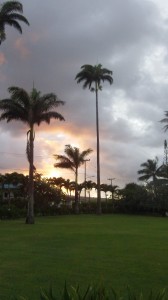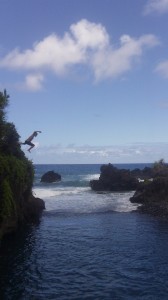Veering Off the Hana Highway
My family and I just returned from a week in Hana, on the eastern coast of Maui. The town is probably best known for the road leading to it –a series of heart-stopping one-lane bridges and sheer vertical drops to the ocean below. But tourists who drive to Hana and back in a day from resorts on the sunnier side of this Hawaiian island miss exploring one of the most isolated and beautiful spots on earth.
We stayed at a home owned by descendants of Claus Spreckels, a nineteenth century businessman who became known as the “sugar king” of Hawaii and a central character in my recent book, Lost Kingdom. Known as Hale Honu (Turtle House,) it overlooks the sea and is located just down the street from the Hana Cultural Center. One of the smaller bedrooms of the house contains the restored wooden bed of the burly sugar baron himself. Each night, we went to sleep to the sounds of the pounding Pacific. In the morning, we ate breakfast on the deck, looking out at the ocean and at the gracious lawns.
Below the house was a natural lava tub: at low tide, all four of us could sit in the protected pool, enjoying the seawater but sheltered from the powerful swells. We learned very quickly to wear our wetsuit booties on the sharp lava rock when we climbed down to the tub or explored the tide pools.
With two energetic teenage boys, we reached out to a local, Shawn Spillett, who runs a company called Hana Productions and manages the local ranch of the famed photographer David LaChapelle, to take us to places that tourists generally never find. Our first day, we kayaked from Hana Bay, around a rocky peninsula, to Kaihalulu, the famous red sand beach. It was a windy day and the waves topped ten feet. Paddling through those swells and then navigating our ocean kayaks through a narrow channel, with dangerous rocks on either side, proved thrilling but also a bit terrifying. At one point, a big swell directly broke over Shawn’s kayak, punching him in the face as he turned to make sure the two kayaks that my husband Charlie and I and our sons Cody and Andrew, were on course.
Since we’d cheated fate by managing to avoid capsizing our kayaks, Shawn wisely decided we should hike out of the beach instead. (He came back later with his crew to paddle the kayaks back at sunset, when the seas had calmed down quite a bit.) That afternoon we hiked several miles across lava to Wai’anapanapa State Park, where we dove into a fresh water pool leading to a wonderfully watery cavern. Afterwards, Shawn gave us a tour of his quirky garden and greenhouse. Shawn’s bride Rachel, after hearing about our day, quipped, “Shawn tends to push people’s limits.” Yes he did – and we loved every minute of it!
The highlight of the second day was the four mile Pipiwai Trail in the Haleakala National Park leading through an eerie bamboo forest to the Waimoku Falls — with a 400-foot vertical drop down sheer lava rock. Then we looped around above the O’heo Gulch (or the seven sacred pools) following a back trail to Kapahu Living Farm, a taro farm tended by a Hawaiian kapuna (elder) named Uncle John, who invited us to enjoy some coconuts from the trees. Shawn cut them down for us and we ate the fresh coconut meat and drank the milk. Afterwards, we hiked down to the tourist-packed waters of the seven sacred pools – probably our least favorite part of the trip.
Afterwards, we ate salad at the Laulima organic farm in Kipahulu, where the young mother who picked the lettuce explained (since she couldn’t offer us forks) that eating the salad with our hands provided more mana (life-force or power.) Eating salad with our hands was something new for all of us. Although we were sad that the farm no longer offered its famous bicycle-powered smoothies, we walked though the farm afterwards, most memorably through resting fields planted with spearmint (with its sharply delicious fragrance releasing as our footsteps crushed the plants’ leaves.) Then Shawn led us through the remains of an old sugar mill, mostly buried already beneath the area’s verdant plant life, and finally to the achingly lovely grounds of the Palapala Ho’omau Church In Kipahulu to see the gravestone of the aviator Charles Lindbergh, who died in Maui in 1974.
Day Three we hiked from Waioka, where we all dove from cliffs into what locals call the Venus Pool, to Hamoa Beach, made famous by James Michener, who praised it as being the most “South Pacific” beach in the North Pacific. We loved it and stayed there until dusk, since Shawn had brought a surfboard, stand-up paddleboard (SUP) and a skim-board for the boys to try. Charlie stayed in the longest, simply floating on a boogie board as a short cloudburst came and brought with it a rainbow.
After such a heavenly afternoon, my husband Charlie and I headed to the Travasaa Hotel Hana (long known as the Hotel Hana Maui) to hear local Leokane Pryor, a falsetto singer with roots in nearby Kipahulu who’s released two albums on the Mountain Apple label. At the bar, Shawn introduced us to Lee-Ann Kahookele-Paman, who sang on two tracks of Leokane’s most recent album, Home Malanai, and who told me that her Hawaiian family could trace its roots through the Kumulipo, the Hawaiian chant translated in 1897 by Hawaii’s last queen, Lili’uokalani, that some scholars have compared to the Greek creation myths and Hebrew genesis. Lee-Ann also brought me up to date on the recent news of the Hawaiian Registry Program, an effort by the Office of Hawaiian Affairs to provide Hawaiians worldwide with a card verifying their Hawaiian ancestry.
We headed back to Hamoa beach the next morning (just a 10 minute drive from the house) and that afternoon, embarked on our final, epic adventure. At mid-day, after lunch, we headed north from the house to the Wailua Valley, following the original and overgrown Hana highway past aquaducts, inching along sheer cliffs, and eating wild guava and passion fruit along the trail. It lightly rained much of the time, as we headed into dense cloud-forest where hunters track down boar. We saw wild orchids, native Koa trees, massive red eucalyptus covered with spongy green moss, and unusual ferns as we mucked our way through a lot of mud. As our 16-year-old Cody said, it was “60% hike, 40% swim.”
We hiked several miles away from the Hana Highway into one of the most remote valleys in the islands, plush with ferns and wild ginger whose blossoms tasted like honeysuckle. We felt exhilarated at the end of the long day (Shawn said we hiked 6 miles or so — but it seemed like a lot more.) We ended up in Keanae, at the arboretum there, and Shawn hitchhiked back to where we’d left the car. The sun went down and near the entrance of the spooky arboretum: a car had tumbled over the edge into a ravine perhaps years ago and was now slowly being absorbed by the jungle. It felt a little like a Twilight Zone episode but even so, a strange and wonderful end to a great day.
After Hana, the town of Paia was a bit of a disappointment. We enjoyed our dinner at Mama’s Fish House, though it was very pricey – especially the fact that the restaurant named the fisherman who caught that evening’s fish. (I ordered the “Ono caught trolling along the north shore of Maui by Jeff Holland” – I kid you not – and my husband. Charlie had the “Opah caught in local waters aboard the fishing vessel “Vak 2” by Jonathan Ganados.” Both were delicious.
But nothing rivaled the mahi-mahi in a vegan curry sauce prepared by the talented Robin Newton, a renowned island chef and caterer, for us the first night we arrived – the fish caught the previous day by her husband Brad, not all that far from the Hana Bay and the wonderful Hale Honu.
Julia Flynn Siler is the bestselling author of “Lost Kingdom: Hawaii’s Last Queen, the Sugar Kings, and America’s First Imperial Adventure,” published by the Atlantic Monthly Press. For more information, please visit www.juliaflynnsiler.com





